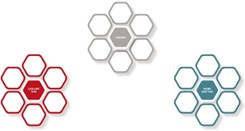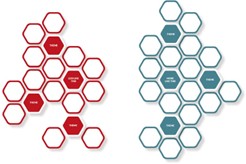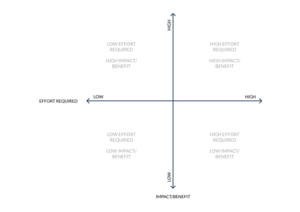More Like this, Less Like That
TIME: Approximately 1 hr 30 minutes
Group size: 3-6 per group, you can run multiple groups at the same time.
MATERIALS: Different colored hexies, pens, wallspace or tables - pre-populated story cards (conversations collected from attendees and conversations in the community) 1 pack of cards per group or additional blank hexies for people to contribute stories.
AIM: To explore the narratives and experiences that currently exist, and decide how to generate more positive experiences and reduce negative ones.
GETTING THE STORIES:
If you have lots of stories, you can give different groups different cards, mix the deck and distribute amongst the groups. You can use filters, such as location, as a way of selecting relevant cards for your workshop. If you need to generate story cards in the workshop, get people to write their stories onto blank hexies, and make sure that all of the stories are shuffled/mixed before starting the exercise.
Each group should nominate a person who is responsible for making sure that everyone has the opportunity to participate and be heard.
STEP BY STEP
1. Getting into groups
Form groups of 3 to 6. Groups should try to have a diversity of roles or characteristics e.g. include people from different generations, different departments within an organization, different roles i.e members of the public, business, public sector.
2. Setting up
Provide each group with a deck of story cards, ideally 20-30 stories (you can use more or less depending on time and how many stories you have available to you). Get 2 cards (color coded), have one say “More like this” and the other say “Less like this’. Place these two cards one at either end of the workspace.
3: Categorize the cards (30 minutes)
The group takes it in turns to select a story card and read it out, each member of the group is to say whether they would like there to be more stories like this in the future or less, and explain briefly why they feel that way. If there is a general agreement in the group, they can cluster the story around the appropriate hexi.
If there is no agreement as to which side the story belongs in, set up a 3rd cluster for those stories.
If you are finding it difficult to decide, ask yourself “If we were doing this same activity in 10 years time, would we still want to see people sharing stories like this?”
4: Identify the themes (10 minutes)
Starting with the ‘More Like This’ cluster, take 10 minutes to group together the stories that have similar themes or topics. Use a different color hexie to label these themes and place them next to the corresponding stories. Repeat the same for the ‘Less Like This’ cluster and the undecided cluster.
5: Develop ideas and actions (20 minutes)
For this part you can choose to work as a whole group or as individuals to come up with some solutions or ideas.
The aim is to think about what actions could be taken that would lead to more stories like those which exist in the ‘More Like This’ cluster, and less stories like the ‘Less Like This’ cluster.
You may want to focus on each of the themes identified.
Your solutions should be actions that match the following criteria:
Something small that individuals or small groups of people could do within a month, it might not fix things, but it would be a step in the right direction or would make things more manageable for now.
If you have time you can also think about medium and long term solutions
Something that might need some more time or resources, and requires other people/ institutions to do things differently. (think in terms of something that might take between 6 months and 2 years to make happen)
An ideal situation if resources and support were unlimited (think about what you would like an ideal scenario to be in the long term)
6: Plot your ideas to decide which one has the greatest impact for the least effort (10 minutes)
This can be done by setting up an X/Y chart as shown below, and placing the intervention ideas on there (page 15 graphs). The idea that has the greatest impact/ benefit and the lowest effort is to be pitched to the wider group.
7: Pitch your ideas and vote (15 minutes)
Each group is to present their idea in 1 minute, explaining what it is and why it is a good thing to do.
8: Vote (5 minutes)
Each of the pitched ideas should be sign posted in different parts of the room.
People should then vote with their feet and stand by the idea that they most support or would like to get involved in (you are not allowed to vote for your own team’s idea).
The number of votes can be used as a way of prioritizing ideas or to form groups who will help work on making them happen!




